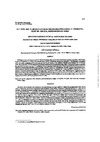Identificador persistente para citar o vincular este elemento:
https://accedacris.ulpgc.es/jspui/handle/10553/1378
| Título: | P-T path and fluid evolution in the Franqueira granitic pegmatite, central Galicia, northwestern Spain | Autores/as: | Fuertes Fuente, Mercedes Martín Izard, Agustín Boiron, M. C. Mangas, José |
Clasificación UNESCO: | 2506 Geología | Palabras clave: | Phase-Equilibria Chrysoberyl Alexandrite Dunite Contact Molar Volume Nw Spain, et al. |
Fecha de publicación: | 2000 | Proyectos: | GBO 91/1077 (CICYT) PB 96/0555 |
Publicación seriada: | Canadian mineralogist | Resumen: | In Galicia, in the northwestern part of the Iberian Peninsula, there are several occurrences of granitic pegmatites. One of them, known as Franqueira, is a metasomatic deposit of gem-quality chrpsoberyl, emerald and phenakite. The pegmatite is associated with a two-mica peraluminous Hercynian granite, and intrude dunites of the Schistose domain in the Galician Tras-Os-Montes Zone. The composition of fluid inclusions in emerald and phenakite has been determined using a Raman microprobe to ascertain the paleofluid chemistry and the P-T conditions of fluid migration in the pegmatite. Three types of fluid inclusions have been identified in emerald and phenakite; three episodes of fluid circulation are distinguished. The first episode is represented by low-salinity aqueous-carbonic primary fluid inclusions in phenakite; these were trapped at 2.5 kbar and 400 degreesC. An isothermal drop in pressure produced a second stage of fluid trapping under conditions of 400 degreesC and 1 kbar. Fluid inclusions trapped in emerald indicate that during this second stage, it formed from phenakite and chrysoberyl in the presence of a CO2- and CH4-rich fluid. A third episode of fluid circulation suggests an independent stage of fluid circulation during late tectonic events, with temperatures ranging from 160 degrees to 265 degreesC and pressure below 0.5 kbar. En Galice, dans le secteur nord-ouest de la Péninsule Ibérique, on trouve plusieurs massifis de pegmattites granitiques. Un de ceux-ci, Franqueira, est le site d’un gisement métasomatique de chrysobéryl, émeraude et phénakite gemmes. La pegmatite est associée á un massif hercynien de granite hyperalumineux à micas, mis dans des dunites du domaine de schistes de la zone Tras-s-Montes. La composition des inclusions fluides dans l’emeraude et la phénakite a été établie su moyen d’une microsonde Raman afin de detérminer la composition du paléofluide et des conditions de pression et de température au cours de sa migration dans la pegmetite. Nous avons identifié trois types d’inclusions fluides dans l’emeraude et la phénakite, qui témoigment de trois épisodes de circulation d’une phase fluide. Le premier a donné des inclusions primaires aqueuses met primaires dans la phénakite, piégées à 2.5 kbar et 400⁰C. Unw chete isotherme de la pression a produit un second stade de piégeage, à 400⁰C et 1 kbar. Les inclusions associées à ce deuixième épisode piégées dans l’emeraude indiquent un mode de sa formation par reemplacement aux dépens de la phénakite et du chrysobéryl par una phase fluide riche en gaz carbonique et en méthane. Un trosième épisode de circulation serait indépendant des deux premiers développé au cors dúne deformation tardive à une température allant de 160⁰ à 265⁰C et une pression inférieure à 0.5 kbar. |
URI: | https://accedacris.ulpgc.es/handle/10553/1378 | ISSN: | 0008-4476 | Fuente: | Canadian Mineralogist [ISSN 0008-4476], v. 38, p. 1163-1175, (Octubre 2000) |
| Colección: | Artículos |
Citas de WEB OF SCIENCETM
Citations
31
actualizado el 25-feb-2024
Visitas
164
actualizado el 30-nov-2024
Descargas
322
actualizado el 30-nov-2024
Google ScholarTM
Verifica
Comparte
Exporta metadatos
Los elementos en ULPGC accedaCRIS están protegidos por derechos de autor con todos los derechos reservados, a menos que se indique lo contrario.
